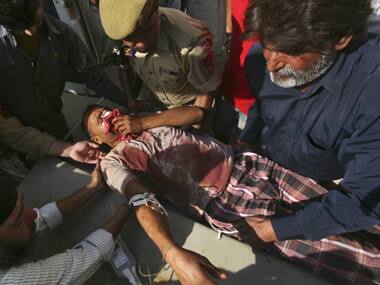The Narendra Modi government deserves kudos for rebuffing Pakistan’s unprovoked cross-border firing by redefining Newton’s third law of motion (“For every action, there is an equal and opposite reaction”) in the political context and substituting it with its own realpolitik template: for every Pakistani shelling, there is double the shelling from India. However, India cannot afford to be complacent, given the deep anti-India mindset of Pakistan’s military establishment. Pakistan may still pull off something from its dirty tricks repertoire in view of massive pressure being built up in Pakistan. This is evident by a large rally organized by the Jamaat-ud-Dawa (JuD) in Karachi on Friday where the JuD activists exhorted the Pakistani government to give a “befitting” response to Indian “aggression” on the borders and wage jihad against India. [caption id=“attachment_1753301” align=“alignleft” width=“380”]  A man injured after fresh shelling from Pakistani side on Sunday. Reuters[/caption] This kind of Indian troop’s response, perhaps the first time in decades, has been quite effective. The result is there before the world as Pakistani guns have fallen silent, by and large, though Pakistani troops violated the ceasefire yet again on Saturday evening in Arina sector of Jammu when they targeted three BSF posts. With this strong and effective retaliation the Modi government has shown how exactly the perennial menace of unprovoked cross-border firing from the Pakistani side should be dealt with. It has also demonstrated that Indian troops are eminently capable of coming up with ‘an eye for an eye, a tooth for a tooth’ kind of response provided the political executive takes a bold decision. One wonders why previous governments could not come up with such a strong response to Pakistan’s provocations on the Line of Control (LoC) and International Border (IB). Incidentally, Pakistan has of late started describing IB as WB or Working Boundary, perhaps taking a leaf out of China’s India diplomacy. Pakistani Rangers, supported by Pakistan Army, had upped the ante since the beginning of this month by heavy shelling along IB and LoC. The Pakistani tactics were rather baffling because most of their shelling was along the IB, which is a settled border and there is no dispute about it. But there was method in Pakistan’s perceived madness. There are several reasons behind the Pakistani strategy. One, it is well known that Pakistani troops resort to unprovoked firing for pushing militants into the Indian territory under the cover of this firing. They focused more on the IB because unlike the LoC, the IB offers the most ideal terrain for infiltrating terrorists. Two, winter is fast approaching and therefore Pakistani military strategists wanted to push in as many terrorists into Indian territory at this time of festival season before heavy snowfall closes passes along the LoC. While major stretches of the IB are fenced, the LoC terrain is such that it cannot be fenced. Pakistan’s military strategists, in their wisdom, may have thought that by creating trouble in a big way on the IB as well as the LoC, they may succeed in pushing good number of terrorists into India. After all, anywhere between 700 and 200 terrorists were ‘waiting’ to cross over into India under the cover of Pakistani firing. Three, apart from approaching winters and the ongoing festival season in India, the state of Jammu and Kashmir is due for assembly elections. The assembly polls were initially meant to be held along with Maharashtra and Haryana but unprecedented floods in the state put paid to such plans. That Pakistan created mayhem on the borders despite the huge humanitarian crisis triggered by ravaging floods shows Pakistan’s apathy to humanitarian causes. It is almost certain that J&K assembly polls will be held by early next year while the winter is still at its peak, therefore, from Pakistan’s perspective, it was imperative to push in as many saboteurs into J&K before winter sets in. Four, Rawalpindi (the headquarters of all-powerful Pakistan Army) wanted to test how strong Prime Minister Narendra Modi actually is. The Pakistani military establishment must have got a fairly clear idea on this score now. One will have to wait and watch what next steps Rawalpindi takes, if any. After all, it is common knowledge that when it comes to Pakistan’s India policy it is Rawalpindi, not Islamabad, which calls the shots. An inevitable question at the present juncture is: what next? The India-Pakistan border clashes will surely take their toll on bilateral relations. While it is obvious that the Modi government won’t be desperate to resume talks with Pakistan, it should also not shy away from handshake diplomacy with Pakistan. Under the circumstances there is nothing substantive India can achieve by resuming the so-called peace process with Pakistan. PM Modi will be traveling to Kathmandu towards the end of next month for attending the SAARC summit. His Pakistani counterpart Nawaz Sharif, too, will be present there. In such a scenario when eight South Asian leaders gather for a regional summit it won’t be pragmatic for Modi to avoid Nawaz Sharif. There will be nothing wrong if Modi indulges in a bit of handshake diplomacy with Sharif to keep the international community quiet. After all such an event will merely be a photo-op and nothing more.
With this strong retaliation the Modi government has shown how the perennial menace of unprovoked cross-border firing from Pakistan should be dealt with.
Advertisement
End of Article
Written by Rajeev Sharma
Consulting Editor, Firstpost. Strategic analyst. Political commentator. Twitter handle @Kishkindha. see more


)

)
)
)
)
)
)
)
)



